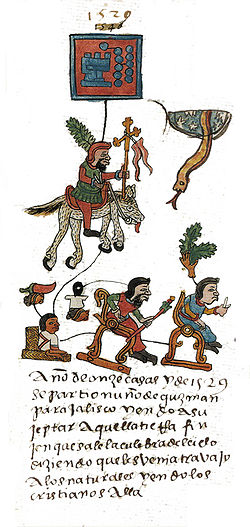- Codex Telleriano-Remensis
-
 Conquistador Nuño Beltrán de Guzmán as depicted in Codex Telleriano Remensis.
Conquistador Nuño Beltrán de Guzmán as depicted in Codex Telleriano Remensis.
The Codex Telleriano-Remensis, produced in sixteenth century Mexico and printed on European paper, is one of the finest surviving examples of Aztec manuscript painting. Its Latinized name comes from Charles-Maurice Le Tellier, archbishop of Reims, who had possession of the manuscript in the late 17th century.[1]
The Codex is held at the Bibliothèque nationale de France in Paris.
Contents
Contents
The Codex Telleriano-Remensis is divided into three sections. The first section, spanning the first seven pages, describes the 365-day solar calendar, called the xiuhpohualli. The second section, spanning pages 8 to 24, is a tonalamatl, describing the 260-day tonalpohualli calendar. The third section is a history, itself divided into two sections which differ stylistically. Pages 25 to 28 are an account of migrations during the 12th and 13th centuries, while the remaining pages of the codex record historical events, such as the ascensions and deaths of rulers, battles, earthquakes, and eclipses, from the 14th century to the 16th century, including events of early Colonial Mexico.
Reproductions
In 1995, a reproduction of the Codex Telleriano-Remensis made from films was published by the University of Texas, with commentary by Eloise Quiñones Keber. During the process of photographing and rebinding the manuscript for this publication, two pages were accidentally swapped around, and appear as such in the facsimile: page 13, with Tecziztecatl on the recto and Nahui Ehecatl on the verso; and page 19, with Tamoanchan on the recto and Codex Xolotl on the verso.[2]
Notes
References
- Evans, Susan Toby; Keber, Eloise Quinones (1997). "Review of Codex Telleriano-Remensis: Ritual, Divination, and History in a Pictorial Aztec Manuscript". Ethnohistory (Ethnohistory, Vol. 44, No. 2) 44 (2): 419–420. doi:10.2307/483388. JSTOR 483388.
- Quiñones Keber, Eloise (1995). Codex Telleriano-Remensis: Ritual, Divination, and History in a Pictorial Aztec Manuscript. University of Texas Press. ISBN 978-0-292-76901-4.
External links
- Loubat edition of the Codex Telleriano Remensis.
- Loubat edition commentary. (French)
- Pedro de los Rios and others (2010-08-13). "Codex Telleriano-Remensis (russian edition).". www.bloknot.info (A.Skromnitsky). http://bloknot.info/files/Textos/Mexico/Codex-385-Telleriano-Remensis-al-ruso.pdf. Retrieved 2011-08-29.
Categories:- Astrological texts
- Mesoamerican codices
- Bibliothèque nationale de France collections
Wikimedia Foundation. 2010.
